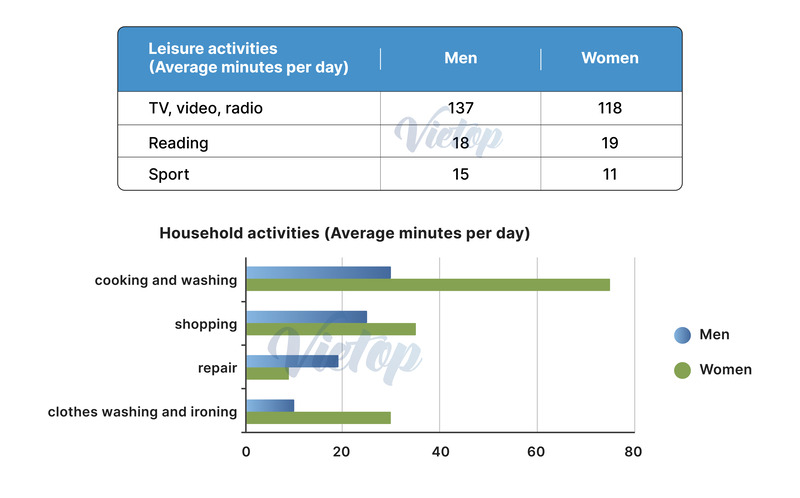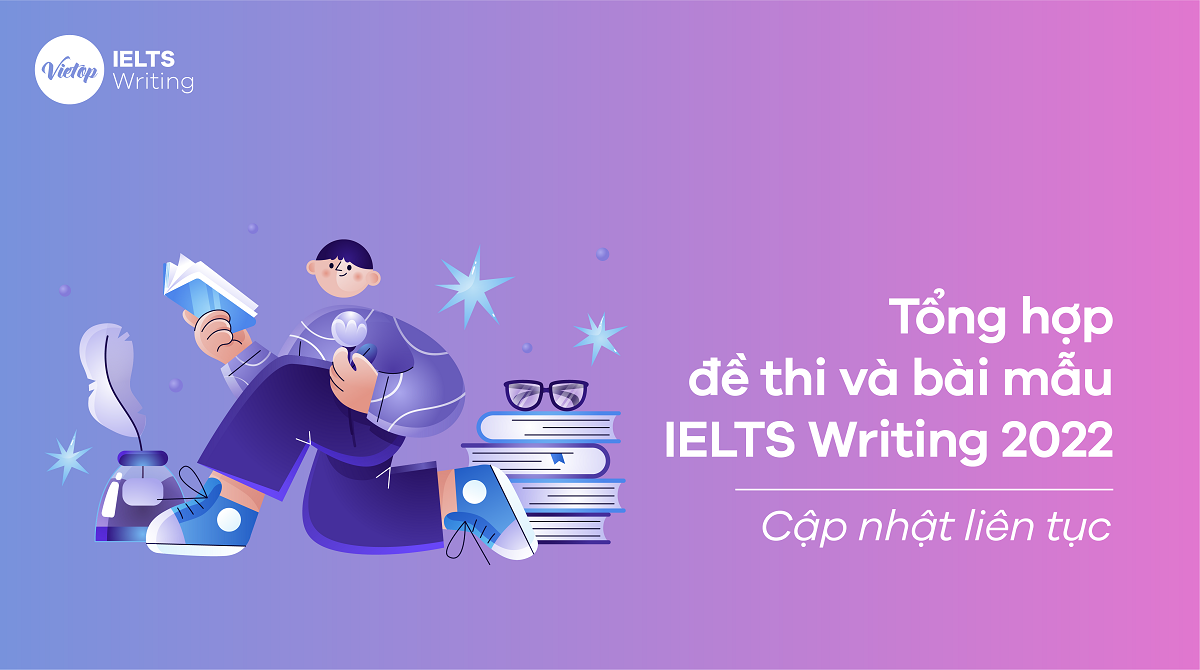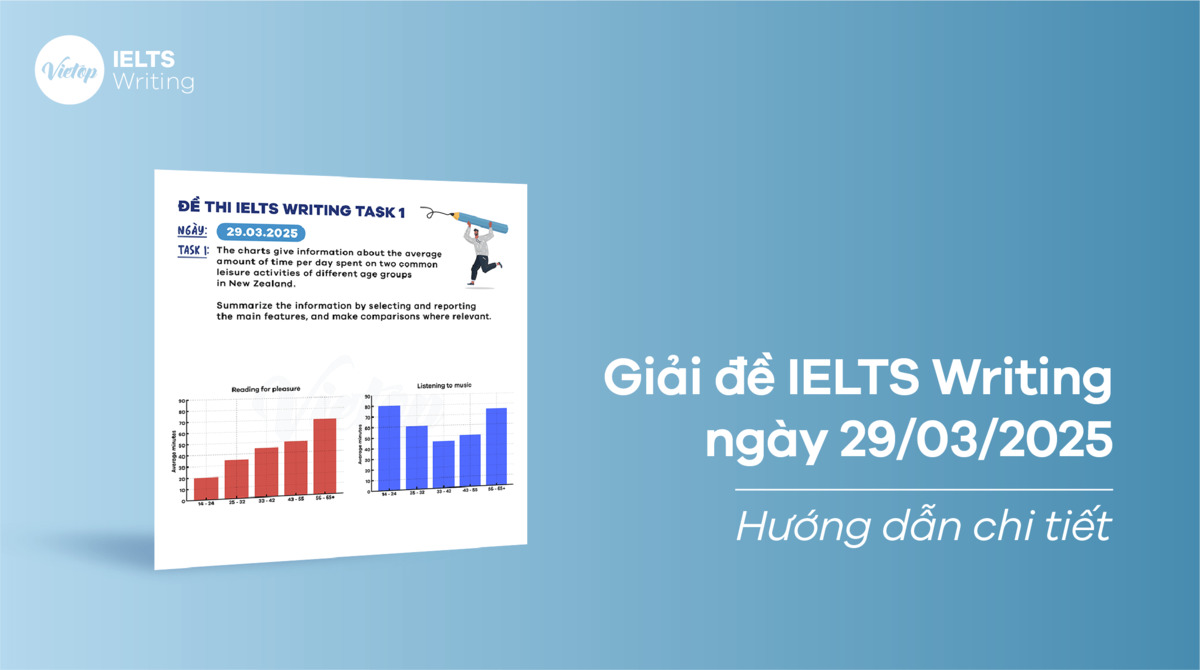Dạng biểu đồ hỗn hợp (mixed-chart), tuy ít khi xuất hiện trong IELTS Writing task 1, đã bất ngờ có mặt trong đề thi ngày 06/07/2024. Mặc dù nhiều thí sinh cảm thấy rằng dạng bài này khá phức tạp vì phải phân tích 2 biểu đồ khác nhau, nhưng thực tế, nó là một trong những dạng bài dễ xử lý. Hãy cùng xem qua đề thi task 1 và task 2 và tìm hiểu cách làm bài dưới đây:
- Đề IELTS Writing task 1: The charts below show the comparison of time spent, in minutes per day, by UK’s Males and Females on household and leisure activities in 2008. Summarise the information by selecting and reporting the main features, and make comparisons where relevant.
- Đề IELTS Writing task 2 thuộc dạng Cause and Solution với chủ đề Museum: Many museums and historical sites are mainly visited by tourists and not local people. Why is this the case? What can be done to attract local people?
Để nắm rõ hơn cách viết task 1 và task 2 trong IELTS Writing, hãy cùng thầy phân tích số liệu trong biểu đồ hỗn hợp của task 1 và trình bày nguyên nhân, giải pháp trong task 2 qua các bài mẫu theo từng band điểm trong bài giải đề thi IELTS Writing ngày 06/07/2024.
1. IELTS Writing task 1
| The charts below show the comparison of time spent, in minutes per day, by UK’s Males and Females on household and leisure activities in 2008. Summarise the information by selecting and reporting the main features, and make comparisons where relevant. |
| (Các biểu đồ dưới đây hiển thị sự so sánh về thời gian dành cho các hoạt động gia đình và giải trí, tính bằng phút mỗi ngày, của nam và nữ tại Vương quốc Anh vào năm 2008. Tóm tắt thông tin bằng cách chọn và báo cáo các đặc điểm chính, và thực hiện so sánh khi cần thiết.) |

1.1. Bước 1: Phân tích đề
- Dạng biểu đồ: Kết hợp giữa bảng số liệu và biểu đồ cột không có sự thay đổi về thời gian.
- Topic: Time spent, in minutes per day, on household and leisure activities.
- Place: The UK.
- Number of factors: Table: 3, Bar chart: 4.
- Time: 2008.
- Tense: Thì quá khứ đơn.
1.2. Bước 2: Lập dàn ý
Introduction: Paraphrase đề bài.
Overview: Men spent more time on leisure activities, particularly watching TV and engaging in sports, whereas women dedicated more time to household chores such as cooking, washing, and ironing.
| Body paragraph 1 | Body paragraph 2 |
| Table: – Men dedicated significantly more time to leisure activities such as watching TV, video, and listening to the radio, averaging 137 minutes per day compared to 118 minutes for women. – Men spent 18 minutes reading, slightly less than the 19 minutes spent by women. – Men allocated 15 minutes to sports activities, while women spent only 11 minutes on the same. | Bar chart: – Men spent approximately 30 minutes on cooking and washing, whereas women spent around 75 minutes daily on these activities. – In terms of shopping, men spent about 25 minutes, while women spent around 35 minutes. – When it came to repair work, men invested nearly 20 minutes, significantly more than the 10 minutes spent by women. – Lastly, men spent about 10 minutes on clothes washing and ironing, in contrast to the 30 minutes spent by women. |
Xem thêm:
- Hướng dẫn cách viết introduction task 1 đơn giản cực hấp dẫn
- Cách viết overview task 1 – Những yếu tố quan trọng cần nắm vững
- Cách nói tăng/ giảm trong IELTS Writing task 1 hay nhất
1.3. Bước 3: Bài mẫu
1.3.1. Bài mẫu band 5.0+
The charts compare the time spent by males and females in the UK on household and leisure activities in 2008, measured in minutes per day.
Overall, men spent more time on leisure activities like TV and sports, while women spent more time on household tasks like cooking and clothes washing.
The table shows that men spent 137 minutes daily on TV, video, and radio, while women spent 118 minutes. Men spent 18 minutes reading and 15 minutes on sports, whereas women spent 19 minutes reading and 11 minutes on sports.
The bar chart indicates that men spent roughly 30 minutes cooking and washing, whereas women spent about 75 minutes. Men spent around 25 minutes shopping, while women spent around 35 minutes. For repair work, men spent nearly 20 minutes and women spent around 10 minutes. Men spent 10 minutes on clothes washing and ironing, while women spent 30 minutes.
Bạn đã từng gặp khó khăn khi làm dạng bài Mixed Chart? Khóa học IELTS 6.0 tại Vietop sẽ tập trung vào việc hướng dẫn học viên rèn luyện kỹ năng phân tích và tổng hợp thông tin một cách chuyên sâu. Với phương pháp giảng dạy cá nhân hoá và đội ngũ giáo viên giàu kinh nghiệm, bạn sẽ được hướng dẫn từng bước để hoàn thiện kỹ năng viết của mình và đạt điểm cao trong kỳ thi IELTS.
1.3.2. Bài mẫu band 7.0+
The charts provide a comparison of the average daily time, in minutes, spent by men and women in the UK on various household and leisure activities in 2008.
Overall, the data reveals that men in the UK spent more time on leisure activities, particularly watching TV and engaging in sports, whereas women dedicated more time to household chores such as cooking, washing, and ironing.
According to the table, men dedicated significantly more time to leisure activities such as watching TV, video, and listening to the radio, averaging 137 minutes per day compared to 118 minutes for women. Men spent 18 minutes reading, slightly less than the 19 minutes spent by women. Additionally, men allocated 15 minutes to sports activities, while women spent only 11 minutes on the same.
The bar chart highlights the gender disparities in household tasks. Men spent approximately 30 minutes on cooking and washing, whereas women spent around 75 minutes daily on these activities. In terms of shopping, men spent about 25 minutes, while women spent around 35 minutes. When it came to repair work, men invested nearly 20 minutes, significantly more than the 10 minutes spent by women. Lastly, men spent about 10 minutes on clothes washing and ironing, in contrast to the 30 minutes spent by women.
1.4. Từ vựng
| Từ vựng | Nghĩa |
| Particularly /pəˈtɪkjʊləli/ | (adverb). đặc biệt E.g.: She loves all her subjects, particularly mathematics. (Cô ấy yêu tất cả các môn học của mình, đặc biệt là môn toán.) |
| Dedicate /ˈdɛdɪkeɪt/ | (verb). cống hiến, dành riêng E.g.: He dedicated his life to helping the poor. (Anh ấy đã cống hiến cả cuộc đời mình để giúp đỡ người nghèo.) |
| Additionally /əˈdɪʃənəli/ | (adverb). thêm vào đó, ngoài ra E.g.: Additionally, the project will create new jobs in the area. (Thêm vào đó, dự án sẽ tạo ra nhiều việc làm mới trong khu vực.) |
| Allocate /ˈæləˌkeɪt/ | (verb). phân bổ E.g.: The government allocated more funds for education. (Chính phủ đã phân bổ thêm ngân sách cho giáo dục.) |
Xem thêm:
- Hướng dẫn cách viết dạng Maps IELTS Writing Task 1
- Cách viết dạng Diagram (Process) IELTS Writing Task 1
- Cách viết Writing Task 1 Line Graph
1.5. Cấu trúc
1.5.1. Câu phức với While/ Whereas
S + V + O, while/ whereas + S + V + O.
E.g.: Poland had the highest youth unemployment rate, while Denmark had the lowest rates for both youth and overall unemployment.
(Ba Lan có tỷ lệ thất nghiệp trong thanh niên cao nhất, trong khi Đan Mạch có tỷ lệ thất nghiệp thấp nhất cả trong thanh niên lẫn tổng thể.)
1.5.2. Cấu trúc câu so sánh nhất
S + V + the highest/ lowest Noun.
E.g.: Poland had the highest youth unemployment rate.
(Ba Lan có tỷ lệ thất nghiệp trong thanh niên cao nhất.)
1.5.3. Cấu trúc câu so sánh hơn
S1 + to be + lower/ higher than S2 hoặc S + V + the lower/ higher Noun.
E.g.: The overall unemployment rate was significantly lower.
(Tỷ lệ thất nghiệp tổng thể thấp hơn đáng kể.)
1.5.4. Mệnh đề quan hệ rút gọn
S + V +O, V_ing + O hoặc S + V + O, V_ed/ V_pp + O.
E.g.: There was a significant increase in the percentage of families owning one car, reaching the same peak as no-car families in 1971, followed by a slight decline.
(Có một sự gia tăng đáng kể trong tỷ lệ các gia đình sở hữu một xe, đạt đỉnh tương tự như các gia đình không có xe vào năm 1971, theo sau là một sự giảm nhẹ.)
Tham khảo ngay khóa học IELTS online tại Vietop English để chung phục giấc mơ du học ngay hôm nay!
2. IELTS Writing task 2
| Many museums and historical sites are mainly visited by tourists and not local people. Why is this the case? What can be done to attract local people? |
| (Nhiều bảo tàng và di tích lịch sử chủ yếu được khách du lịch ghé thăm chứ không phải người dân địa phương. Tại sao lại như vậy? Cần làm gì để thu hút người dân địa phương?) |
2.1. Bước 1: Phân tích đề
- Dạng bài: Cause and solution (Yêu cầu thí sinh chỉ ra nguyên nhân của vấn đề và đề xuất giải pháp để xử lý vấn đề).
- Từ khóa: Museums and historical sites, tourists, not local people, why, what, attract local people.
- Phân tích yêu cầu: Đề bài yêu cầu bạn chỉ ra nguyên nhân của tình trạng nhiều bảo tàng và di tích lịch sử chủ yếu được khách du lịch ghé thăm chứ không phải người dân địa phương và đề xuất giải pháp để thu hút người dân địa phương ghé thăm bảo tàng và di tích lịch sử.
2.2. Bước 2: Lập dàn ý
| Introduction: Viết lại đề bài theo cách khác, sau đó đề cập nguyên nhân và giải pháp. | |
| Body paragraph 1: Nguyên nhân | Body paragraph 2: Giải pháp |
| – Main idea 1: One reason why local people do not visit museums and historical sites is because they think they already know about their own history and culture. + Supporting idea: They might have learned about these places in school or heard about them from family and friends. On the other hand, tourists find these places new and exciting because they want to learn about a different culture and history. + Main idea 2: Another reason is that local people are often busy with their daily lives. +Supporting idea: They do not have enough time to visit museums and historical sites. Tourists, however, are on vacation and have more free time to explore and visit different places. | – Main idea 1: One way is to have special events or programs that are interesting to local people. + Supporting idea: For example, museums can have local art shows, music performances, or history talks. These events can make the museums more attractive to local people. – Main idea 2: Another way is to offer discounts or free entry for local people. + Supporting idea: Many people may not visit museums because they think it is expensive. By offering lower prices or free days for local residents, more people might be encouraged to visit. |
| In conclusion: Viết lại mở bài theo cách khác, nhắc lại nguyên nhân và giải pháp. Tóm tắt các main idea đã viết trong các đoạn thân bài. | |
Xem thêm:
- Cách viết mở bài Writing Task 2 cuốn hút
- Cách viết Topic sentence cho phần thi IELTS Writing
- Cách viết Conclusion trong IELTS Writing task 2
2.3. Bước 3: Bài mẫu
2.3.1. Bài mẫu band 5.0+
Museums and historical sites are important for learning about history and culture. However, it is often noticed that tourists visit these places more than local people. There are a few reasons for this situation, and some ways to make local people visit more often.
One reason why local people do not visit museums and historical sites is because they think they already know about their own history and culture. They might have learned about these places in school or heard about them from family and friends. On the other hand, tourists find these places new and exciting because they want to learn about a different culture and history. Another reason is that local people are often busy with their daily lives. They do not have enough time to visit museums and historical sites. Tourists, however, are on vacation and have more free time to explore and visit different places.
To attract local people to museums and historical sites, some steps can be taken. One way is to have special events or programs that are interesting to local people. For example, museums can have local art shows, music performances, or history talks. These events can make the museums more attractive to local people. Another way is to offer discounts or free entry for local people. Many people may not visit museums because they think it is expensive. By offering lower prices or free days for local residents, more people might be encouraged to visit.
In conclusion, tourists visit museums and historical sites more than local people because locals think they already know their history or are too busy. To attract more local visitors, museums can organize special events and offer discounts or free entry.
2.3.2. Bài mẫu band 7.0+
Museums and historical sites play a crucial role in educating individuals about the past and cultural heritage. However, there is a noticeable trend where tourists tend to outnumber local residents in their visits to these places. This essay delves into the reasons behind this phenomenon and proposes strategies to attract more local visitors.
One primary explanation for the disparity in visitation between tourists and locals is that the latter may perceive themselves as well-informed about their own history and culture. Local residents may have acquired knowledge about these sites through academic institutions or through informal sources like familial narratives. Conversely, tourists are drawn to these destinations due to their novelty and the opportunity to delve into a different cultural and historical context. Additionally, local residents often face time constraints due to their daily obligations, which hinder their ability to frequent museums and historical sites. In contrast, tourists, being in a vacation mode, possess more leisure time to engage in exploration and visitation.
To enhance the appeal of museums and historical sites among local residents, several measures can be implemented. One effective approach is to organize tailored events or programs that cater to the interests of the local community. For instance, museums can host exhibitions showcasing local artwork, musical performances, or educational sessions on local history. These initiatives have the potential to make cultural institutions more alluring to local residents. Moreover, offering discounts or complimentary entry to museums can serve as a compelling incentive for local individuals to visit these sites. The perception of museums as expensive venues might deter many locals from attending. Hence, by introducing affordable pricing schemes or designated days with free entry for residents, museums can attract a more diverse local audience.
In conclusion, the preference of tourists over local residents in visiting museums and historical sites can be attributed to locals’ perceived familiarity with their own heritage and time constraints. To reverse this trend and entice a greater number of local visitors, museums can diversify their offerings by organizing culturally relevant events and implementing pricing strategies that make visits more accessible to the local community.
2.4. Từ vựng
| Từ vựng | Nghĩa |
| Delve into /dɛlv ˈɪntuː/ | (verb phrase). đi sâu vào E.g.: The researcher delved into the history of the ancient civilization. (Nhà nghiên cứu đã đi sâu vào lịch sử của nền văn minh cổ đại.) |
| Novelty /ˈnɒvəlti/ | (noun). sự mới lạ E.g.: The novelty of the idea attracted many investors. (Sự mới lạ của ý tưởng đã thu hút nhiều nhà đầu tư.) |
| Hinder /ˈhɪndər/ | (verb). cản trở E.g.: Bad weather can hinder the construction process. (Thời tiết xấu có thể cản trở quá trình xây dựng.) |
| Implement /ˈɪmplɪmɛnt/ | (verb). thực hiện, triển khai E.g.: The company plans to implement a new marketing strategy. (Công ty có kế hoạch triển khai một chiến lược tiếp thị mới.) |
| Cater to /ˈkeɪtər tuː/ | (verb phrase). phục vụ, đáp ứng E.g.: The restaurant caters to all dietary preferences. (Nhà hàng phục vụ tất cả các sở thích ăn kiêng.) |
| Alluring /əˈljʊərɪŋ/ | (adjective). quyến rũ, hấp dẫn E.g.: The alluring fragrance of the flowers filled the room. (Hương thơm quyến rũ của những bông hoa tràn ngập căn phòng.) |
| Deter /dɪˈtɜːr/ | (verb). ngăn chặn, làm nản lòng E.g.: High prices can deter customers from buying. (Giá cao có thể ngăn cản khách hàng mua hàng.) |
| Attributed to /əˈtrɪbjutɪd tuː/ | (verb phrase). được cho là do E.g.: The success of the project is largely attributed to the team’s hard work. (Sự thành công của dự án phần lớn được cho là do công sức làm việc chăm chỉ của cả đội.) |
Xem thêm cách viết các dạng bài khác:
- Cách viết dạng Positive & Negative – IELTS Writing Task 2
- Cách viết Discussion Essay trong IELTS Writing Task 2
- Cách viết Discuss Both View And Give Your Opinion trong IELTS Writing Task 2
2.5. Cấu trúc
2.5.1. Cấu trúc câu phức với while
While + S + V + O, S + V + O.
E.g.: While I am a big fan of playing video games, my best friend is fond of watching movies.
(Trong khi tôi rất thích chơi trò chơi điện tử, bạn thân của tôi lại thích xem phim.)
2.5.2. Mệnh đề quan hệ rút gọn
S + V + O, V_ing + O hoặc S + V + O, V_ed +by + O.
E.g.: Online games can impact children’s eyes, leading to a reduction in their health.
(Trò chơi trực tuyến có thể ảnh hưởng đến mắt của trẻ em, dẫn đến sức khỏe của chúng suy giảm.)
2.5.3. Mệnh đề quan hệ với which, that làm chủ ngữ
S + V + O which/ that + V + O.
E.g.: He found the key that opens the secret door.
(Anh ta tìm thấy chiếc chìa khóa mở cánh cửa bí mật.)
2.5.4. Mệnh đề quan hệ với where
S + V + O where S + V + O.
E.g.: Denmark was the only country where youth unemployment was lower than the European average.
(Đan Mạch là quốc gia duy nhất có tỷ lệ thất nghiệp trong thanh niên thấp hơn mức trung bình của châu Âu.)
Xem thêm:
- [ACE THE TEST] Giải đề IELTS Writing ngày 22/06/2024
- [ACE THE TEST] Giải đề IELTS Writing ngày 15/06/2024
- [ACE THE TEST] Giải đề IELTS Writing ngày 08/06/2024
- [ACE THE TEST] Giải đề IELTS Writing ngày 25/05/2024
Chúng ta vừa hoàn thành bài phân tích giải đề IELTS Writing ngày 06/07/2024, bao gồm cả task 1 với dạng biểu đồ hỗn hợp và task 2 với dạng nguyên nhân-giải pháp. Sau khi học cách phân tích đề, lập dàn ý và viết bài mẫu, các bạn cảm thấy đề thi hôm nay ra sao? Nếu có bất kỳ câu hỏi nào, hãy để lại bình luận dưới bài viết để thầy có thể trả lời nhanh chóng.
Để cập nhật xu hướng đề thi IELTS Writing trong tương lai, các bạn có thể theo dõi bộ đề tổng hợp IELTS Writing năm 2024 do thầy và đội ngũ biên tập của Vietop English đã biên soạn. Bộ đề không chỉ bao gồm các đề thi mà còn có cả bài giải mẫu chi tiết, giúp bạn luyện thi một cách hiệu quả.
Để đạt được điểm số mong muốn trong IELTS Writing, việc luyện tập đều đặn và nhận phản hồi từ các giáo viên là rất quan trọng. Nếu bạn đang tìm kiếm sự hỗ trợ tận tình từ giáo viên, các khóa học IELTS tại Vietop chính là lựa chọn lý tưởng để bạn hoàn thành mục tiêu IELTS của mình. Đừng để thời gian và công sức của bạn bị lãng phí – hãy bắt đầu học IELTS cùng Vietop ngay hôm nay!
Chúc các bạn luyện thi IELTS thành công!


![[ACE THE TEST] Giải đề IELTS Writing ngày 07/04/2025](https://vietop.edu.vn/wp-content/uploads/2025/04/giai-de-ielts-writing-ngay-07-04-2025.png)

![[ACE THE TEST] Giải đề IELTS Writing ngày 15/03/2025](https://vietop.edu.vn/wp-content/uploads/2025/03/giai-de-ielts-writing-ngay-15-03-2025.jpg)
![[ACE THE TEST] Giải đề IELTS Writing ngày 22/03/2025](https://vietop.edu.vn/wp-content/uploads/2025/03/giai-de-ielts-writing-ngay-22-03-2025.jpg)
![[ACE THE TEST] Giải đề IELTS Writing ngày 08/03/2025](https://vietop.edu.vn/wp-content/uploads/2025/03/giai-de-ielts-writing-ngay-08-03-2025.jpg)
![[ACE THE TEST] Giải đề IELTS Writing ngày 06/03/2025](https://vietop.edu.vn/wp-content/uploads/2025/03/giai-de-ielts-writing-ngay-06-03-2025.jpg)
![[ACE THE TEST] Giải đề IELTS Writing ngày 22/02/2025](https://vietop.edu.vn/wp-content/uploads/2025/02/giai-de-ielts-writing-ngay-22-02-2025.jpg)
